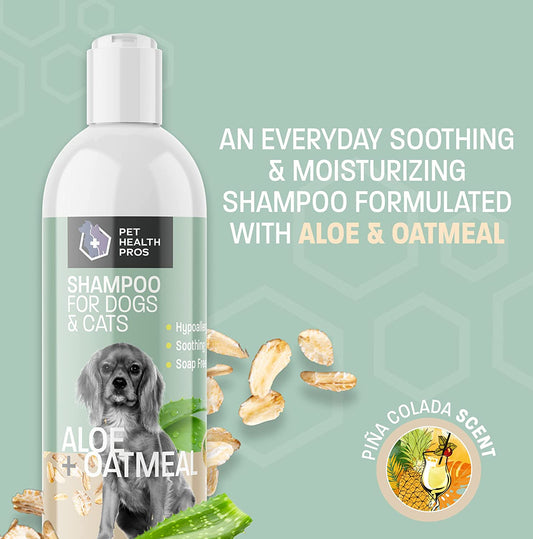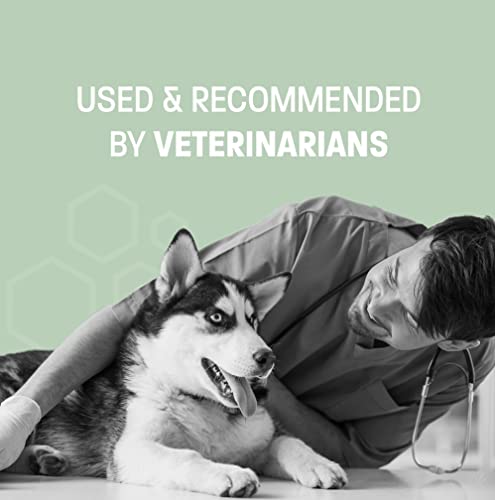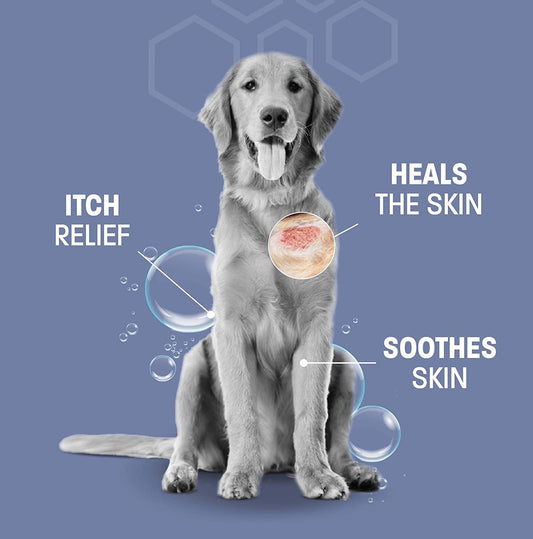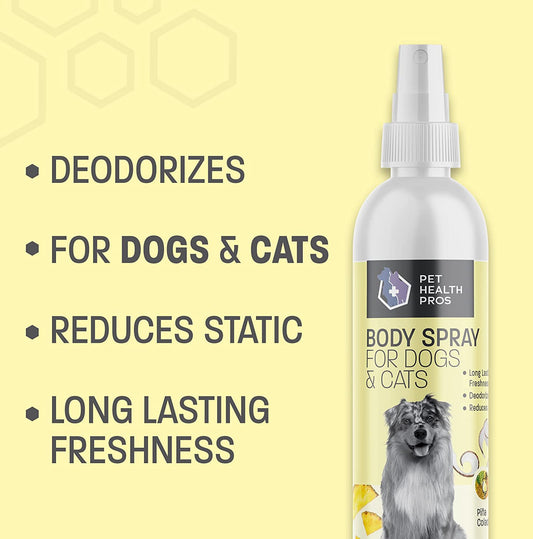Yeast in a dog's paws can cause immense discomfort. Pet Health Pros is here to guide you on recognizing the symptoms and understanding the role our medicated products play in alleviating this condition.
The fight against yeast in dog paws is a constant challenge for pet owners. Candida fungus causes this common infection, which can cause pain and irritation. So, it's important to be aware of the signs and symptoms in order to help our furry friends.
Yeast infections don't just appear in ears; they can also happen on a dog's paws. Red, itchy, and irritated skin in between the toes or on the paw pads is a sign. Dogs may also lick or chew their paws due to the discomfort. If left untreated, more serious issues like secondary bacterial infections can occur.
To make life easier for our four-legged pals, there are ways to battle yeast in their paws. One way is to make sure to clean their paws regularly with an antifungal solution from your vet. This removes moisture and helps get rid of any existing yeast.
It's also important to keep their paws dry. After outdoor time, dry them off with a clean towel or use a low setting blow dryer. Moisture encourages yeast growth, so drying is key.
Make sure their paws have proper ventilation. Avoid tight shoes or socks that can trap sweat. Instead, get breathable booties or shoes designed for dogs that let air flow through while protecting their paws.
On top of that, give your dog a balanced diet full of protein and other nutrients. This will help their immune system fight off fungal infections.
Understanding Yeast Infections in Dog Paws
To better understand yeast infections in dog paws, delve into the sub-sections: What is yeast and how does it affect dog paws?, Causes of yeast infections in dog paws, Common signs and symptoms of yeast in dog paws. This will provide you with a comprehensive understanding of the problem and its potential solutions.
What is yeast and how does it affect dog paws?
Yeast, a type of fungus, can affect dog paws and cause discomfort. This is known as a yeast infection, when the yeast multiplies and disrupts the natural balance on the skin.
Yeast thrives in warm and humid environments, like between a dog's paws. To help prevent this, keep paws clean and dry. Wash regularly and keep the environment clean and dry.
Apply antifungal treatments specifically designed for dogs' paws. Follow the instructions from your vet or the product label.
Dietary changes may be beneficial. Foods high in carbs may contribute to yeast overgrowth. Consider a balanced diet with limited carbs. Ask your vet for tailored guidance.
Regular grooming is important too. Trim excess hair around the paw pads to reduce moisture retention. Regular check-ups will help keep paws healthy.
By implementing these suggestions, you can manage yeast infections in your pup's paws. Cleanliness, antifungal treatments, and diet changes can restore the natural balance and prevent future occurrences. Always consult with a vet to ensure the best course of action.
Causes of yeast infections in dog paws
Yeast infections in a dog's paws can have many causes. These include allergies, moisture and warmth, poor hygiene, and weakened immune systems. Each dog can also have specific conditions that make them more likely to get an infection. It's essential to watch your pet for any signs and talk to a vet!
So, make sure you inspect your pup's paws regularly, clean them, and groom them properly. Create a dry environment so yeast doesn't grow. Taking these preventative steps will help avoid any discomfort caused by yeast infections. Give your furry buddy the care they deserve!
Common signs and symptoms of yeast in dog paws
Yeast infections in dog paws can be tricky to spot. So, if your pup is showing any of these signs, take action straight away!
- Itching: Your doggo may be scratching or licking their paws.
- Redness & Swelling: The affected area might be red and swollen.
- Discharge & Odor: A foul-smelling discharge from the paws, with a distinct smell.
- Paw Pad thickening: The skin on the paw pads may be thicker and rougher.
- Pain Sensitivity: Displaying signs of pain when touched or pressure applied.
Each pup may have different symptoms. So, if you're worried, reach out to a vet for an accurate diagnosis. They'll advise the best treatment plan for your pup.
Recognizing the signs of a yeast infection quickly is key. That way, your pup won't suffer any discomfort.
Diagnosing Yeast Infections in Dog Paws
To diagnose yeast infections in your dog's paws, recognizing the signs is crucial. In this section, we'll explore how to recognize these infections and the importance of seeking veterinary care for a proper diagnosis. By understanding these sub-sections, you'll be better equipped to identify and address any potential yeast issues in your furry friend's paws.
How to recognize yeast infection in dog paws
Spotting yeast infection in your dog's paws requires close observation. Here are 5 ways to recognize it:
- Watch for excessive licking or biting of the paws, plus frequent scratching. These usually show discomfort due to a yeast infection.
- Look for redness, swelling, or irritation on the paw pads. Yeast infections often cause inflammation and skin sensitivity.
- Smell for an odour like musty or yeasty coming from the paws. This is a sign of a yeast infection.
- Check for changes in skin texture. Roughness or scaliness of the paw pads may be a symptom.
- Notice any discharge or ooze from the affected area. Yeast infections can cause extra wetness of the skin.
Remember, factors such as allergies, humid environments, and weak immune systems can make yeast infections worse. So prevention is important. To prevent and manage yeast infections:
- Keep your pet's paws clean and dry. Wipe them after walks or in wet weather.
- Use products specially designed for treating yeast infections on dogs' paw pads.
- Feed your dog a balanced diet with essential nutrients for a strong immune system.
- Ask your vet about antifungal powders or creams to treat existing infections.
- Regularly inspect and clean other places prone to yeast infection, like ears and folds of skin.
By following these tips, you'll be able to look after your pup's paw yeast infection and boost their overall wellbeing. Seek vet advice for persistent or serious cases. Timely detection and treatment are essential for your pet's happiness and health.
Seeking veterinary care for proper diagnosis
Sarah's beloved canine companion experienced persistent itching between their toes. She tried home remedies, but they didn't help. So, Sarah sought veterinary care for proper diagnosis.
Veterinary exam: A qualified vet must look over the dog to detect a yeast infection.
Medical history review: The vet will ask questions about the pup's symptoms, past infections, and any health issues that could contribute.
Physical exam: Close inspection of the paws, like looking and touching, reveals signs like redness, swelling, discharge, or thickening.
Lab testing: Skin scrapings or cytology tests may be done to confirm the presence of yeast.
Culture and sensitivity testing: In some cases, a sample is taken from the affected area for lab analysis to determine the particular type of yeast and guide treatment options.
Further diagnostic measures: If underlying causes are suspected, more tests like allergy or blood work may be recommended.
Timely vet attention prevents discomfort and complications. Pet owners should also keep their pup's paws clean and dry after outdoor activities and avoid wet environments. With prompt action and vet intervention, Sarah's golden retriever's paw condition improved in weeks.
When it comes to yeast infections in dog paws, professional diagnosis is the key. If your furry friend shows signs of distress or unusual symptoms, seek vet care right away.
Treating Yeast Infections in Dog Paws
To effectively treat yeast infections in your dog's paws, turn to antifungal treatments and medications for a solution. Additionally, explore home remedies specifically designed for treating yeast in dog paws. Lastly, implement preventive measures to avoid recurring infections.
Antifungal treatments and medications
Topical antifungal creams or ointments can be applied directly to the affected area. These products work by blocking the growth of yeast, to get rid of the infection.
Oral antifungal meds might be prescribed by a vet for more serious cases. These target the yeast from inside the body, for a systemic treatment approach.
It's necessary to clean the paws regularly, to remove extra moisture and debris that help yeast grow. This can be done using mild soap and water or paw wipes especially made for this.
Some natural remedies may help too, like rinses with apple cider vinegar, coconut oil applications, and probiotic supplements.
Stopping future infections needs good paw hygiene, keeping the paws dry and clean, steering clear of irritants such as grass pesticides or chemical cleaners, and providing your dog a balanced diet to maintain immunity.
Consulting with a vet is a must for accurate diagnosis and proper treatment. They can give advice on the best antifungal treatments and drugs for your pup's needs.
It's essential to complete the full course of treatment as given by your vet, to make sure antifungal treatments and medications work properly.
Home remedies for treating yeast in dog paws
Treating yeast infections in a pet's paws can be tricky. Here are some easy home remedies to help provide relief and promote paw health:
- Clean and dry the paws thoroughly. Use a gentle cleanser or antifungal solution for dogs. This helps remove moisture and stops yeast growth.
- Mix equal parts water and apple cider vinegar for an anti-yeast solution. Apply with a clean cloth or cotton pad. The acidity helps balance the skin's pH levels.
- Coconut oil has antimicrobial properties, making it good for treating yeast infections. Massage a small amount directly to the infected paws. Do this regularly to soothe irritation.
- Include probiotics in the diet. These regulate gut flora, affecting microorganisms throughout the body, including the paws. Look for pet-specific probiotics and follow dosage instructions.
- Keep the environment clean. Wash bedding and vacuum carpets or rugs to reduce potential sources of irritation or allergens. This helps with both treatment and prevention.
A combination of these home remedies helps pet owners actively address yeast infections while promoting paw health. It offers both short-term relief and long-term prevention.
Preventive measures to avoid recurring infections
It is essential to take preventive measures to keep your pup's paws safe from recurrent infections. Here are a few tips to keep your four-legged buddy healthy:
- Regular paw hygiene - After walks or outdoor activities, use a mild antiseptic solution to clean your dog's paws thoroughly. This will eliminate any possible fungal or bacterial growth.
- Keep paws dry - Excessive moisture can lead to yeast growth. Make sure to dry your pup's paws after water or wet surfaces.
- Paw inspection - Check your dog's paws for signs of redness, swelling, or excessive licking regularly. Catching early symptoms can stop the infection from developing.
Also, certain breeds with floppy ears or long hair are more prone to yeast infections due to more moisture and heat in those areas.
Dealing with Chronic Yeast Infections in Dog Paws
To effectively address chronic yeast infections in your dog's paws, it's crucial to understand the underlying causes and make necessary changes. Identifying the root causes and modifying the diet and lifestyle are key solutions discussed in this section. By delving into these sub-sections, you'll gain insights into managing and alleviating your furry friend's persistent yeast infections.
Identifying underlying causes for chronic yeast infections
Chronic yeast infections in dog paws can be really pesky. It's so important to get to the root of the problem. Identifying underlying causes is the key!
One potential trigger: Allergies. Your pup may have an allergy to foods, mold, pollen or fleas. When his body fights these allergens, it weakens his skin and allows yeast to take over.
Another culprit: Imbalance in your dog's microbiome. Good bacteria on his skin help keep yeast away. But things like too much shampooing or bathing can throw off this balance and welcome yeast infections.
Underlying health issues can also cause trouble. Hormonal imbalances or a weak immune system can make your pup more prone. Knowing these underlying issues will help you treat and prevent future infections.
Pro Tip: Ask your vet to help. They can do tests to get to the bottom of it and give you solutions to manage and stop future infections.
Changes in diet and lifestyle to manage chronic infections
To manage issues, it's important to change your fur baby's diet and lifestyle. Get a high-quality, grain-free dog food and provide filtered water for your pup. Omega-3 fatty acids and probiotics to their diet can help prevent future infections.
Exercise is also vital. Take your pup on daily walks or engage in playtime activities. This will keep them physically fit and boost their immune system.
Lastly, make sure their paws are clean and dry. Moist areas encourage yeast growth, so use hypoallergenic baby wipes after walks or an anti-fungal powder. This will reduce the risk of infection.
Conclusion
Pet Health Pros strives for your dog's optimum health. Trust our expert advice and medicated products to tackle yeast afflictions in dog paws.
Dogs can have yeast in their paws, with various signs and symptoms. Not just paws, it can happen in other parts too, like the ears. To deal with this, you need to spot the signs early and get treatment.
One sign of yeast in dog paws is licking or chewing too much. If your pup's feet are getting a lot of attention, it could be from an infection. An odor, redness, and swelling could also happen.
Yeast infections can cause ear problems as well. Itchy ears, ear infections, and shaking the head are signs. If you don't treat yeast, it could lead to other health issues.
Max was a Golden Retriever who had itchy and biting paws for weeks. He went to the vet and had a severe yeast infection. With medication and cleaning, Max got better and his owner was relieved.
Spotting the signs of yeast in dog paws is important. Taking action quickly can help the pup feel better and stay healthy. Healthy paws make for a happy pup!
Frequently Asked Questions
Q: What are the signs and symptoms of yeast infection in dog paws?
A: Some common signs of yeast infection in dog paws include excessive licking or chewing of the paws, redness or inflammation, a foul odor, thickened or discolored skin, and the presence of crusty or greasy debris between the toes.
Q: Can yeast infection in dog paws spread to other parts of the body?
A: Yes, yeast infection in dog paws can spread to other parts of the body if left untreated. It is important to address the infection promptly to prevent it from spreading to the ears, groin, or other areas of the skin.
Q: How can I treat yeast infection in my dog's paws?
A: Treatment for yeast infection in dog paws often involves a combination of antifungal medication, topical treatments, and proper hygiene. Your veterinarian may recommend antifungal shampoos, creams, or oral medication to address the infection. It is important to follow your veterinarian's instructions and complete the full course of treatment.
Q: Can I use home remedies to treat yeast infection in my dog's paws?
A: While some home remedies may provide temporary relief, it is best to consult with your veterinarian for proper diagnosis and treatment of yeast infection in dog paws. Home remedies may not effectively address the underlying cause of the infection and could potentially worsen the condition.
Q: How can I prevent yeast infection in my dog's paws?
A: To prevent yeast infection in dog paws, it is important to keep the paws clean and dry, avoid over-bathing, use a hypoallergenic or medicated shampoo if recommended by your veterinarian, regularly trim excessive hair between the toes, and provide a balanced diet to support a healthy immune system.
Q: When should I consult a veterinarian for my dog's yeast infection?
A: It is recommended to consult a veterinarian if you suspect your dog has a yeast infection in the paws. Your veterinarian can provide a proper diagnosis, recommend appropriate treatment options, and help prevent the infection from spreading or recurring.








